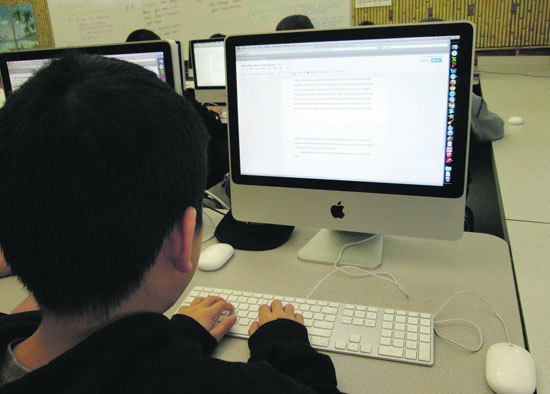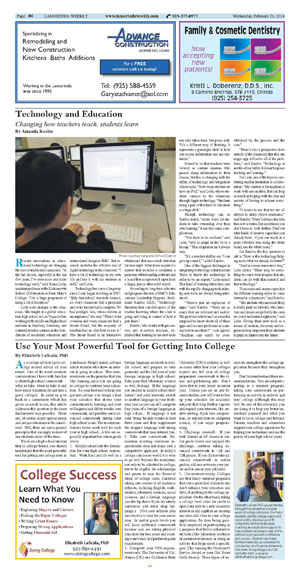| | Published February 26th, 2014
| Technology and Education
Changing how teachers teach, students learn
| | By Amanda Kuehn |  | | Photo courtesy Lafayette School District |
Recent innovations in educational technology are changing the face of traditional classrooms. "In the last decade, especially in the last five years, I've seen more and more technology used," said Raina León, assistant professor in the Kalmanovitz School of Education at Saint Mary's College. "I'm a huge proponent of using a lot of resources."
 León is no stranger to the classroom. She taught at a global education high school in Las Vegas before working with middle and high school students in Bambery, Germany, and currently teaches courses on the foundations of secondary education and instructional design at SMC. Her research includes the effective use of digital technology in the classroom. "I have a lot of technology in my own life and use it with my students as well," said León. León is no stranger to the classroom. She taught at a global education high school in Las Vegas before working with middle and high school students in Bambery, Germany, and currently teaches courses on the foundations of secondary education and instructional design at SMC. Her research includes the effective use of digital technology in the classroom. "I have a lot of technology in my own life and use it with my students as well," said León.
 Technology has come a long way since León began teaching in 2007. "[My first school] was tech-focused, so every classroom had a projector and every teacher had a computer. We had multiple labs, but no tablets or smartphones," she said. "Then I went overseas and every classroom had a Smart Board, but the majority of teachers had no idea how to use it." The Smart Board is an interactive whiteboard that uses touch detection for user input. It functions as part of a system that includes a computer, a projector, whiteboarding software and a board that accepts touch input from a finger, pen or other solid object. Technology has come a long way since León began teaching in 2007. "[My first school] was tech-focused, so every classroom had a projector and every teacher had a computer. We had multiple labs, but no tablets or smartphones," she said. "Then I went overseas and every classroom had a Smart Board, but the majority of teachers had no idea how to use it." The Smart Board is an interactive whiteboard that uses touch detection for user input. It functions as part of a system that includes a computer, a projector, whiteboarding software and a board that accepts touch input from a finger, pen or other solid object.
 According to long-time educator and program director of SMC's Educational Leadership Program, Heidimarie Rambo, Ed.D., "Technology threatens that comfort space of the teacher knowing where the class is going and being in control of how it gets there."
According to long-time educator and program director of SMC's Educational Leadership Program, Heidimarie Rambo, Ed.D., "Technology threatens that comfort space of the teacher knowing where the class is going and being in control of how it gets there."
 Rambo, who works with pre-service and in-service teachers, explained that learning to use new tools not only takes time, but poses risk. "It's a different way of thinking. It represents a paradigm shift in how you access information and use materials."
Rambo, who works with pre-service and in-service teachers, explained that learning to use new tools not only takes time, but poses risk. "It's a different way of thinking. It represents a paradigm shift in how you access information and use materials."
 It used to be that teachers were viewed as content masters who passed along information to their classes, but this is changing with the influx of technology and integration of new tools. "Now every student can have an iPad," said León, whose students connect to the classroom through Apple technology. "Students being a part of that kind of education is a huge shift." It used to be that teachers were viewed as content masters who passed along information to their classes, but this is changing with the influx of technology and integration of new tools. "Now every student can have an iPad," said León, whose students connect to the classroom through Apple technology. "Students being a part of that kind of education is a huge shift."
 Though technology can, as Rambo noted, "create ways for students to take ownership over their own learning," it can also cause complications.
Though technology can, as Rambo noted, "create ways for students to take ownership over their own learning," it can also cause complications.
 "You have to be resilient," said León, "able to adapt on the fly to a hiccup." That adaptation isn't always easy. "You have to be resilient," said León, "able to adapt on the fly to a hiccup." That adaptation isn't always easy.
 "It's a mindset shift to say 'I can give up control,'" added Rambo.
"It's a mindset shift to say 'I can give up control,'" added Rambo.
 One of the biggest challenges in integrating technology is that teachers "have to know the technology in order to be an expert," León noted. That kind of learning takes time, and with the rapidly changing tech industry, new tools are always being introduced. One of the biggest challenges in integrating technology is that teachers "have to know the technology in order to be an expert," León noted. That kind of learning takes time, and with the rapidly changing tech industry, new tools are always being introduced.
 "There's just an explosion of apps," said Rambo. "There are so many that are relevant and usable. The problem is how am I as a teacher supposed to know about all of these apps and become proficient in learning how to use them?" León agreed. "Teachers can easily be overwhelmed by the process and the cost." "There's just an explosion of apps," said Rambo. "There are so many that are relevant and usable. The problem is how am I as a teacher supposed to know about all of these apps and become proficient in learning how to use them?" León agreed. "Teachers can easily be overwhelmed by the process and the cost."
 "There's also a perspective from outside of the classroom that this one magic app will solve all of the problems," said Rambo. "Technology is not the silver bullet. It doesn't replace teaching and learning."
"There's also a perspective from outside of the classroom that this one magic app will solve all of the problems," said Rambo. "Technology is not the silver bullet. It doesn't replace teaching and learning."
 For León, one of the keys to combatting teacher frustration is collaboration. "My caution is for teachers to work with one another; that can help so much in helping with the fear and anxiety of having to relearn something." For León, one of the keys to combatting teacher frustration is collaboration. "My caution is for teachers to work with one another; that can help so much in helping with the fear and anxiety of having to relearn something."
 "It seems to me that we are all subject to shiny object syndrome," said Rambo."There's always this idea that new is better. But sometimes you don't have to look further. Find out what kinds of creative capacities you already have. If you can teach in a more effective way using the white board, use the white board."
"It seems to me that we are all subject to shiny object syndrome," said Rambo."There's always this idea that new is better. But sometimes you don't have to look further. Find out what kinds of creative capacities you already have. If you can teach in a more effective way using the white board, use the white board."
 For Rambo, the key question to ask is "How is this technology helping us do what we already do better?"
For Rambo, the key question to ask is "How is this technology helping us do what we already do better?"
 "And in a more innovative way," León added. "There may be something we can't even imagine that students can do with that material and that technology." "And in a more innovative way," León added. "There may be something we can't even imagine that students can do with that material and that technology."
 "It accesses and creates capacities for different learning styles to come forward in a classroom," said Rambo.
"It accesses and creates capacities for different learning styles to come forward in a classroom," said Rambo.
 "The students who are most likely to really push us forward, who innovate and dream are probably the ones we don't understand right now," said León. Giving them new tools as a means of creation, discovery and expression may empower these students to push us further into the future. "The students who are most likely to really push us forward, who innovate and dream are probably the ones we don't understand right now," said León. Giving them new tools as a means of creation, discovery and expression may empower these students to push us further into the future.

|
| | | | | | | | | | |



